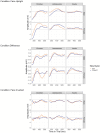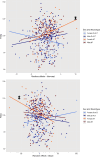Sex differences in social brain neural responses in autism: temporal profiles of configural face-processing within data-driven time windows
- PMID: 38890406
- PMCID: PMC11189412
- DOI: 10.1038/s41598-024-64387-9
Sex differences in social brain neural responses in autism: temporal profiles of configural face-processing within data-driven time windows
Abstract
Face-processing timing differences may underlie visual social attention differences between autistic and non-autistic people, and males and females. This study investigates the timing of the effects of neurotype and sex on face-processing, and their dependence on age. We analysed EEG data during upright and inverted photographs of faces from 492 participants from the Longitudinal European Autism Project (141 neurotypical males, 76 neurotypical females, 202 autistic males, 73 autistic females; age 6-30 years). We detected timings of sex/diagnosis effects on event-related potential amplitudes at the posterior-temporal channel P8 with Bootstrapped Cluster-based Permutation Analysis and conducted Growth Curve Analysis (GCA) to investigate the timecourse and dependence on age of neural signals. The periods of influence of neurotype and sex overlapped but differed in onset (respectively, 260 and 310 ms post-stimulus), with sex effects lasting longer. GCA revealed a smaller and later amplitude peak in autistic female children compared to non-autistic female children; this difference decreased in adolescence and was not significant in adulthood. No age-dependent neurotype difference was significant in males. These findings indicate that sex and neurotype influence longer latency face processing and implicates cognitive rather than perceptual processing. Sex may have more overarching effects than neurotype on configural face processing.
© 2024. The Author(s).
Conflict of interest statement
M-CL has received editorial honorarium from SAGE Publications. JB has been a consultant to/member of advisory board of/and/or speaker for Takeda/Shire, Roche, Medice, Angelini, Janssen, and Servier. He is not an employee of any of these companies, and not a stock shareholder of any of these companies. He has no other financial or material support, including expert testimony, patents, royalties. TC has served as a paid consultant to F. Hoffmann-La Roche Ltd. and Servier; and has received royalties from Sage Publications and Guilford Publications. The remaining authors declare no competing interests of any kind.
Figures




Similar articles
-
Qualitative differences in the spatiotemporal brain states supporting configural face processing emerge in adolescence in autism.Cortex. 2022 Oct;155:13-29. doi: 10.1016/j.cortex.2022.06.010. Epub 2022 Jul 14. Cortex. 2022. PMID: 35961249
-
Abnormal spatiotemporal processing of emotional facial expressions in childhood autism: dipole source analysis of event-related potentials.Eur J Neurosci. 2008 Jul;28(2):407-16. doi: 10.1111/j.1460-9568.2008.06328.x. Eur J Neurosci. 2008. PMID: 18702712
-
Sex differences in automatic emotion regulation in adolescents with autism spectrum disorder.Autism Res. 2022 Apr;15(4):712-728. doi: 10.1002/aur.2678. Epub 2022 Feb 1. Autism Res. 2022. PMID: 35103402 Free PMC article.
-
Investigating the Face Inversion Effect in Autism Across Behavioral and Neural Measures of Face Processing: A Systematic Review and Bayesian Meta-Analysis.JAMA Psychiatry. 2023 Oct 1;80(10):1026-1036. doi: 10.1001/jamapsychiatry.2023.2105. JAMA Psychiatry. 2023. PMID: 37405787 Free PMC article.
-
EEG Biomarkers for Autism: Rational, Support, and the Qualification Process.Adv Neurobiol. 2024;40:545-576. doi: 10.1007/978-3-031-69491-2_19. Adv Neurobiol. 2024. PMID: 39562457 Review.
Cited by
-
HD-tDCS effects on social impairment in autism spectrum disorder with sensory processing abnormalities: a randomized controlled trial.Sci Rep. 2025 Mar 21;15(1):9772. doi: 10.1038/s41598-025-93631-z. Sci Rep. 2025. PMID: 40118999 Free PMC article. Clinical Trial.
References
-
- American Psychiatric Association . Diagnostic and Statistical Manual of Mental Disorders. 5. American Psychiatric Association; 2013.
-
- Maenner MJ, Shaw KA, Baio J, Washington A, Patrick M, DiRienzo M, et al. Prevalence of autism spectrum disorder among children aged 8 years-autism and developmental disabilities monitoring network, 11 sites, United States, 2016. MMWR Surveill. Summ. 2020;69:1–12. doi: 10.15585/MMWR.SS6904A1. - DOI - PMC - PubMed
MeSH terms
Grants and funding
LinkOut - more resources
Full Text Sources

